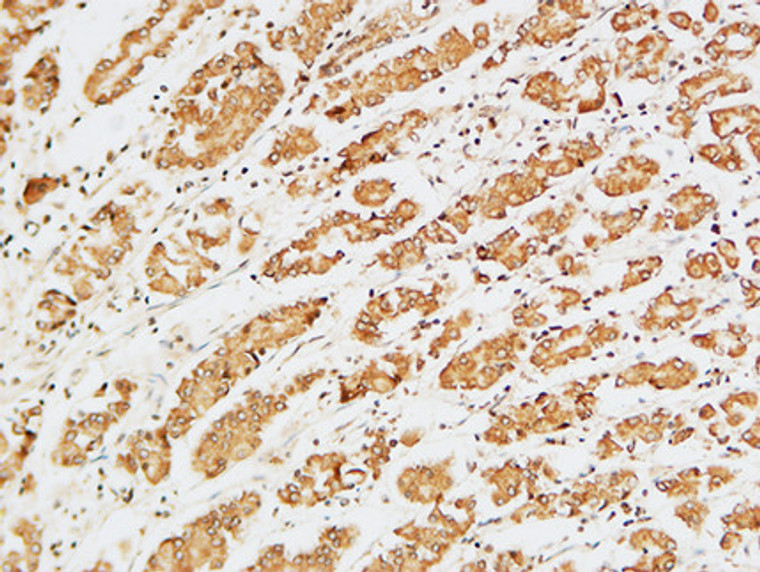| Host: |
Rabbit |
| Applications: |
WB/IHC/IF/ELISA |
| Reactivity: |
Human/Rat/Mouse |
| Note: |
STRICTLY FOR FURTHER SCIENTIFIC RESEARCH USE ONLY (RUO). MUST NOT TO BE USED IN DIAGNOSTIC OR THERAPEUTIC APPLICATIONS. |
| Short Description: |
Rabbit polyclonal antibody anti-Telomerase reverse transcriptase (931-980 aa) is suitable for use in Western Blot, Immunohistochemistry, Immunofluorescence and ELISA research applications. |
| Clonality: |
Polyclonal |
| Conjugation: |
Unconjugated |
| Isotype: |
IgG |
| Formulation: |
Liquid in PBS containing 50% Glycerol, 0.5% BSA and 0.02% Sodium Azide. |
| Purification: |
The antibody was affinity-purified from rabbit antiserum by affinity-chromatography using epitope-specific immunogen. |
| Concentration: |
1 mg/mL |
| Dilution Range: |
WB 1:500-1:2000IHC-P 1:100-1:300ELISA 1:20000IF 1:50-200 |
| Storage Instruction: |
Store at-20°C for up to 1 year from the date of receipt, and avoid repeat freeze-thaw cycles. |
| Gene Symbol: |
TERT |
| Gene ID: |
7015 |
| Uniprot ID: |
TERT_HUMAN |
| Immunogen Region: |
931-980 aa |
| Specificity: |
TERT Polyclonal Antibody detects endogenous levels of TERT protein. |
| Immunogen: |
The antiserum was produced against synthesized peptide derived from the C-terminal region of human TERT at the amino acid range 931-980 |
| Post Translational Modifications | Phosphorylation at Tyr-707 under oxidative stress leads to translocation of TERT to the cytoplasm and reduces its antiapoptotic activity. Dephosphorylated by SHP2/PTPN11 leading to nuclear retention. Phosphorylation at Ser-227 by the AKT pathway promotes nuclear location. Phosphorylation at the G2/M phase at Ser-457 by DYRK2 promotes ubiquitination by the EDVP complex and degradation. Ubiquitinated by the EDVP complex, a E3 ligase complex following phosphorylation at Ser-457 by DYRK2. Ubiquitinated leads to proteasomal degradation. (Microbial infection) In case of infection by HIV-1, the EDVP complex is hijacked by HIV-1 via interaction between HIV-1 Vpr and DCAF1/VPRBP, leading to ubiquitination and degradation. |
| Function | Telomerase is a ribonucleoprotein enzyme essential for the replication of chromosome termini in most eukaryotes. Active in progenitor and cancer cells. Inactive, or very low activity, in normal somatic cells. Catalytic component of the teleromerase holoenzyme complex whose main activity is the elongation of telomeres by acting as a reverse transcriptase that adds simple sequence repeats to chromosome ends by copying a template sequence within the RNA component of the enzyme. Catalyzes the RNA-dependent extension of 3'-chromosomal termini with the 6-nucleotide telomeric repeat unit, 5'-TTAGGG-3'. The catalytic cycle involves primer binding, primer extension and release of product once the template boundary has been reached or nascent product translocation followed by further extension. More active on substrates containing 2 or 3 telomeric repeats. Telomerase activity is regulated by a number of factors including telomerase complex-associated proteins, chaperones and polypeptide modifiers. Modulates Wnt signaling. Plays important roles in aging and antiapoptosis. |
| Protein Name | Telomerase Reverse TranscriptaseHest2Telomerase Catalytic SubunitTelomerase-Associated Protein 2Tp2 |
| Database Links | Reactome: R-HSA-171319Reactome: R-HSA-201722 |
| Cellular Localisation | NucleusNucleolusNucleoplasmChromosomeTelomereCytoplasmPml BodyShuttling Between Nuclear And Cytoplasm Depends On Cell CyclePhosphorylation StatesTransformation And Dna DamageDiffuse Localization In The NucleoplasmEnriched In Nucleoli Of Certain Cell TypesTranslocated To The Cytoplasm Via Nuclear Pores In A Crm1/Ran-Dependent Manner Involving Oxidative Stress-Mediated Phosphorylation At Tyr-707Dephosphorylation At This Site By Shp2 Retains Tert In The NucleusTranslocated To The Nucleus By Phosphorylation By Akt |
| Alternative Antibody Names | Anti-Telomerase Reverse Transcriptase antibodyAnti-Hest2 antibodyAnti-Telomerase Catalytic Subunit antibodyAnti-Telomerase-Associated Protein 2 antibodyAnti-Tp2 antibodyAnti-TERT antibodyAnti-EST2 antibodyAnti-TCS1 antibodyAnti-TRT antibody |
Information sourced from Uniprot.org
12 months for antibodies. 6 months for ELISA Kits. Please see website T&Cs for further guidance













